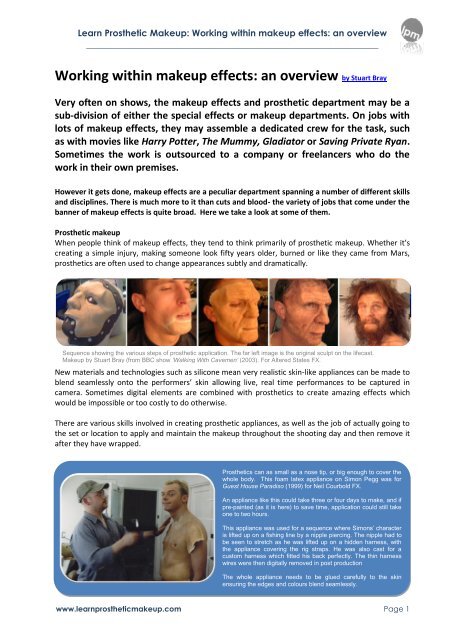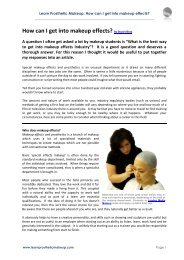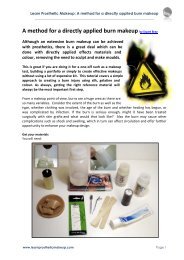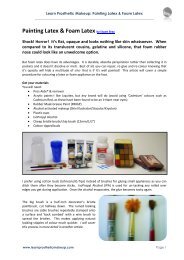Working within makeup effects: an overview by Stuart Bray - Learn ...
Working within makeup effects: an overview by Stuart Bray - Learn ...
Working within makeup effects: an overview by Stuart Bray - Learn ...
Create successful ePaper yourself
Turn your PDF publications into a flip-book with our unique Google optimized e-Paper software.
<strong>Learn</strong> Prosthetic Makeup: <strong>Working</strong> <strong>within</strong> <strong>makeup</strong> <strong>effects</strong>: <strong>an</strong> <strong>overview</strong><br />
________________________________________________________________<br />
<strong>Working</strong> <strong>within</strong> <strong>makeup</strong> <strong>effects</strong>: <strong>an</strong> <strong>overview</strong> <strong>by</strong> <strong>Stuart</strong> <strong>Bray</strong><br />
Very often on shows, the <strong>makeup</strong> <strong>effects</strong> <strong>an</strong>d prosthetic department may be a<br />
sub-division of either the special <strong>effects</strong> or <strong>makeup</strong> departments. On jobs with<br />
lots of <strong>makeup</strong> <strong>effects</strong>, they may assemble a dedicated crew for the task, such<br />
as with movies like Harry Potter, The Mummy, Gladiator or Saving Private Ry<strong>an</strong>.<br />
Sometimes the work is outsourced to a comp<strong>an</strong>y or freel<strong>an</strong>cers who do the<br />
work in their own premises.<br />
However it gets done, <strong>makeup</strong> <strong>effects</strong> are a peculiar department sp<strong>an</strong>ning a number of different skills<br />
<strong>an</strong>d disciplines. There is much more to it th<strong>an</strong> cuts <strong>an</strong>d blood- the variety of jobs that come under the<br />
b<strong>an</strong>ner of <strong>makeup</strong> <strong>effects</strong> is quite broad. Here we take a look at some of them.<br />
Prosthetic <strong>makeup</strong><br />
When people think of <strong>makeup</strong> <strong>effects</strong>, they tend to think primarily of prosthetic <strong>makeup</strong>. Whether it’s<br />
creating a simple injury, making someone look fifty years older, burned or like they came from Mars,<br />
prosthetics are often used to ch<strong>an</strong>ge appear<strong>an</strong>ces subtly <strong>an</strong>d dramatically.<br />
Sequence showing the various steps of prosthetic application. The far left image is the original sculpt on the lifecast.<br />
Makeup <strong>by</strong> <strong>Stuart</strong> <strong>Bray</strong> (from BBC show ‘Walking With Cavemen’ (2003). For Altered States FX.<br />
New materials <strong>an</strong>d technologies such as silicone me<strong>an</strong> very realistic skin-like appli<strong>an</strong>ces c<strong>an</strong> be made to<br />
blend seamlessly onto the performers’ skin allowing live, real time perform<strong>an</strong>ces to be captured in<br />
camera. Sometimes digital elements are combined with prosthetics to create amazing <strong>effects</strong> which<br />
would be impossible or too costly to do otherwise.<br />
There are various skills involved in creating prosthetic appli<strong>an</strong>ces, as well as the job of actually going to<br />
the set or location to apply <strong>an</strong>d maintain the <strong>makeup</strong> throughout the shooting day <strong>an</strong>d then remove it<br />
after they have wrapped.<br />
Prosthetics c<strong>an</strong> as small as a nose tip, or big enough to cover the<br />
whole body. This foam latex appli<strong>an</strong>ce on Simon Pegg was for<br />
Guest House Paradiso (1999) for Neil Courbold FX.<br />
An appli<strong>an</strong>ce like this could take three or four days to make, <strong>an</strong>d if<br />
pre-painted (as it is here) to save time, application could still take<br />
one to two hours.<br />
This appli<strong>an</strong>ce was used for a sequence where Simons’ character<br />
is lifted up on a fishing line <strong>by</strong> a nipple piercing. The nipple had to<br />
be seen to stretch as he was lifted up on a hidden harness, with<br />
the appli<strong>an</strong>ce covering the rig straps. He was also cast for a<br />
custom harness which fitted his back perfectly. The thin harness<br />
wires were then digitally removed in post production<br />
The whole appli<strong>an</strong>ce needs to be glued carefully to the skin<br />
ensuring the edges <strong>an</strong>d colours blend seamlessly.<br />
www.learnprosthetic<strong>makeup</strong>.com Page 1
<strong>Learn</strong> Prosthetic Makeup: <strong>Working</strong> <strong>within</strong> <strong>makeup</strong> <strong>effects</strong>: <strong>an</strong> <strong>overview</strong><br />
________________________________________________________________<br />
Sculpting<br />
Sculpting is <strong>an</strong> essential part of the<br />
department, <strong>an</strong>d whether it’s <strong>an</strong><br />
ear tip to turn Spock into a Vulc<strong>an</strong>,<br />
a whole body ‘creature-suit’ to<br />
make Hellboy look fearsome or a<br />
battlefield of bloodied corpses on<br />
Omaha beach, ch<strong>an</strong>ces are there<br />
has been some kind of sculpture<br />
involved.<br />
Martin Rezard sculpts a Minotaur maquette in plasteline<br />
for Inkheart (2008) for Millennium FX.<br />
The scale of sculpting c<strong>an</strong> vary<br />
enormously from subtle prosthetic appli<strong>an</strong>ces which need to have pore perfect<br />
detail, to huge oversized creatures which may require a whole team of<br />
sculptors. Ideas <strong>an</strong>d designs may be sketched out on paper or made as<br />
‘maquettes’-small scale versions which c<strong>an</strong> show the producers the idea<br />
without the materials <strong>an</strong>d cost involved in a full size version.<br />
Full sized eleph<strong>an</strong>t ‘stunt trunk’<br />
sculpt in clay for ‘Alex<strong>an</strong>der’<br />
(2004).<br />
Sculpt <strong>by</strong> <strong>Stuart</strong> <strong>Bray</strong> & Waldo<br />
Mason. For Neil Courbold FX.<br />
Sculpting commercially like this is as much<br />
pragmatic problem solving as it is creative.<br />
There is rarely time to indulge the artistic urges<br />
m<strong>an</strong>y sculptors have, as this is only one aspect<br />
of the process. Once you have your sculpted<br />
form, you then need to make <strong>an</strong> object from<br />
it which c<strong>an</strong> be used during filming<br />
New technologies me<strong>an</strong> digital models c<strong>an</strong> be sculpted too, either as a<br />
design tool to simply show concepts or to create the final version. Sculpting<br />
software such as ZBrush, Mudbox <strong>an</strong>d modo are used to create virtual<br />
models which c<strong>an</strong> later be output in a lightweight material for moulding<br />
without the need for clay-useful where massive sculptures would<br />
need literally tons of material.<br />
Sculptor Martin Rezard used ZBrush<br />
to create this classically themed bust.<br />
Even with computers, the sculptor still needs to underst<strong>an</strong>d form <strong>an</strong>d<br />
shape in order to create convincing work (after all, simply having a<br />
word processor does not make you a novelist). Doing it this way c<strong>an</strong> save<br />
time <strong>an</strong>d money, allowing for m<strong>an</strong>y more variations of design before committing to a final concept.<br />
Moulding & casting<br />
Once you have your sculpture, you need to<br />
reproduce it in <strong>an</strong> appropriate material. You sculpt<br />
<strong>an</strong> original form in clay because it’s <strong>an</strong> easy material<br />
to push around <strong>an</strong>d work to your intended shape.<br />
Once you have that form, you then need to make a<br />
mould so that you c<strong>an</strong> make rubber versions.<br />
Anything which is made from a mould is known as a<br />
‘cast’, <strong>an</strong>d care must be taken to ensure that each<br />
cast is useable.<br />
Good moulding is essential, as once the mould is<br />
made your original sculpture is usually ruined in the<br />
The eleph<strong>an</strong>t trunk has<br />
been sprayed with a<br />
silver waterproof sealer<br />
to prevent the clay from<br />
drying out.<br />
Clay walls are added to<br />
enable the mould to be<br />
made in a number of<br />
sections. The various<br />
pieces will then fit<br />
together perfectly,<br />
allowing easy removal of<br />
the casts.<br />
Large moulds such as<br />
this need to be both<br />
strong <strong>an</strong>d lightweight.<br />
Fibreglass is often used<br />
in this inst<strong>an</strong>ce.<br />
www.learnprosthetic<strong>makeup</strong>.com Page 2
<strong>Learn</strong> Prosthetic Makeup: <strong>Working</strong> <strong>within</strong> <strong>makeup</strong> <strong>effects</strong>: <strong>an</strong> <strong>overview</strong><br />
________________________________________________________________<br />
process. This doesn’t matter though, as you now have a copy of the sculpture in reverse-out of which<br />
you c<strong>an</strong> cast out multiple copies. It may be that you need one or fifty casts - they’ll all come from the<br />
same mould, <strong>an</strong>d they’ll all need to be useable. Sometimes processes c<strong>an</strong> go wrong, <strong>an</strong>d mouldmakers<br />
will need to solve the problems that occur.<br />
Fibreglass <strong>an</strong>d polyester resin used to create a supporting jacket for a<br />
silicone mould. Mould <strong>by</strong> <strong>Stuart</strong> <strong>Bray</strong> for BBC TV’s Waking the Dead<br />
(2008) for Waldo Mason.<br />
Lifecasting<br />
If you need to give <strong>an</strong> actor a groovy-looking Vampire forehead, you’ll<br />
need a copy of his real forehead to sculpt the appli<strong>an</strong>ce onto if it is to fit<br />
perfectly. This is why lifecasting is <strong>an</strong> essential skill to the department, as it<br />
is the first step in the process of creating a custom prosthetic appli<strong>an</strong>ce.<br />
Lifecasts of heads, h<strong>an</strong>ds <strong>an</strong>d whole bodies c<strong>an</strong> be done quickly with a<br />
skilled crew. Once the original is cast, a master mould is usually made so<br />
that duplicates c<strong>an</strong> be made.<br />
Moulds <strong>an</strong>d casts c<strong>an</strong> be made from a variety of<br />
different materials depending on the requirements<br />
<strong>an</strong>d the budget for the project. Mouldmakers need<br />
to be skilled with all of them, <strong>an</strong>d be able to judge<br />
which materials are right for the job.<br />
Moulding c<strong>an</strong> generate a lot of work with master<br />
moulds, duplicates, inner cores, <strong>an</strong>d multiple casts<br />
all coming through the mould shop doors. Very<br />
often toxic chemicals <strong>an</strong>d materials are used, so<br />
good air extraction <strong>an</strong>d health <strong>an</strong>d safety need to<br />
be observed to operate safely.<br />
The intention is to get <strong>an</strong> accurate copy of the performers face or body,<br />
<strong>an</strong>d if the performer has been released for a short time or needs to leave<br />
promptly, there is a lot of pressure to get it done right . As it is critical this<br />
be done correctly <strong>an</strong>d comfortably, lifecasting requires a lot of practice to<br />
perform competently.<br />
A plaster lifecast fresh from <strong>an</strong><br />
alginate mould taken directly from<br />
the face. Photo courtesy Ed<br />
Woodward-www.sculpt-ed.com<br />
Seaming<br />
Often moulds are made in more one piece, which me<strong>an</strong>s<br />
there will be seam lines to be removed. Good mouldmaking<br />
<strong>an</strong>d casting skill will reduce the severity of seams, but there<br />
are often imperfections to be made good before a cast c<strong>an</strong><br />
be used.<br />
Sometimes a cast could be perfectly useable except for a small imperfection such as a<br />
tear or <strong>an</strong> air bubble. In this inst<strong>an</strong>ce, a good finisher c<strong>an</strong> rescue the cast <strong>an</strong>d remove<br />
the necessity to make <strong>an</strong>other instead. If the cast in question is a prosthetic appli<strong>an</strong>ce<br />
where there may be close-up shots involved, good seaming <strong>an</strong>d repair is essential.<br />
This silicone severed head is from Dracula (2006) for Kristy<strong>an</strong> Mallet- www.kristy<strong>an</strong>mallett.com.<br />
Fresh from the mould <strong>an</strong>d you c<strong>an</strong> clearly see the seams <strong>an</strong>d excess silicone, known as flashing. This<br />
needs to be carefully cut away, <strong>an</strong>d <strong>an</strong>y visible seams filled <strong>an</strong>d made to match the surrounding texture<br />
<strong>an</strong>d colour.<br />
www.learnprosthetic<strong>makeup</strong>.com Page 3
<strong>Learn</strong> Prosthetic Makeup: <strong>Working</strong> <strong>within</strong> <strong>makeup</strong> <strong>effects</strong>: <strong>an</strong> <strong>overview</strong><br />
________________________________________________________________<br />
Painting & finishing<br />
Once the cast is perfect, it may need painting<br />
<strong>an</strong>d finishing. If the object in question is a full<br />
size body, for example, there is a lot to do. The<br />
body will need to be painted to match real skin,<br />
using washes <strong>an</strong>d layers of colour to gradually<br />
build up a realistic finish. Once the painting is<br />
done, there may be hair to add. In the case of<br />
heads, a wig may be used-easy enough you<br />
may think. What about the arms, legs, armpits,<br />
beard stubble <strong>an</strong>d eyebrows<br />
In this inst<strong>an</strong>ce, a process known as hair<br />
punching is used. A small needle is used to<br />
insert hair into the surface of the material, one<br />
<strong>by</strong> one! It takes a long time to do, <strong>an</strong>d even<br />
longer to get good at it. Hum<strong>an</strong> hair lies in<br />
different directions, <strong>an</strong>d often hair has to be<br />
mixed, precurled <strong>an</strong>d cut correctly in order to<br />
sit right on the body. Look carefully at your<br />
own eyebrows, <strong>an</strong>d see how m<strong>an</strong>y subtle<br />
ch<strong>an</strong>ges there are in direction, length <strong>an</strong>d<br />
colour. It is <strong>an</strong> incredible skilled area, <strong>an</strong>d not<br />
for the faint-hearted.<br />
A silicone head made <strong>by</strong> prosthetic <strong>makeup</strong> artist Adri<strong>an</strong><br />
Rig<strong>by</strong> has been painted <strong>an</strong>d hairpunched to create a very<br />
realistic finish.<br />
Each hair is carefully inserted individually, ensuring that<br />
each hair lies in the correct direction.<br />
Animatronics<br />
Animatronics c<strong>an</strong> cover a simple push-pull rod mech<strong>an</strong>ism to a<br />
complete radio controlled creature with computer operated lip-sync to<br />
match pre recorded dialogue. Essentially, the job involves designing<br />
<strong>an</strong>d making one off custom mech<strong>an</strong>isms. Animatronic engineers (or<br />
‘mechs’ as they are known) need to be skilled in using tools such as<br />
lathes <strong>an</strong>d milling machines, <strong>an</strong>d be able to weld, solder <strong>an</strong>d use radio<br />
controls. All of these skills will need to be used to create specific<br />
movements which will look realistic, so add puppeteering to the skills<br />
needed to be a good mech.<br />
This <strong>an</strong>imatronic head mech<strong>an</strong>ism of the<br />
Vogon character ‘Jeltz’ was made <strong>by</strong><br />
<strong>an</strong>imatronic designers Gustav Hoegen <strong>an</strong>d<br />
Richard Darwin for the movie ‘The<br />
Hitchhiker's Guide to the Galaxy’ (2005).<br />
For Jim Henson’s Creature Shop<br />
Over their mech<strong>an</strong>ism will usually be a finished ‘skin’ which hides all<br />
their hard work, until the finished creation comes to life blinking,<br />
smiling <strong>an</strong>d frowning on cue. Sometimes they may be required to<br />
create st<strong>an</strong>d-alone mech<strong>an</strong>isms such as a prop or puppet. However,<br />
sometimes it will need to be something which attaches safely to a<br />
performer as part of a <strong>makeup</strong>. Imagine Quasimodo with a blinking eye,<br />
a demon with wings that need to open <strong>an</strong>d close or <strong>an</strong> oversized alien<br />
head on a hum<strong>an</strong> actor with six moving eyes. The physical size of the<br />
mech<strong>an</strong>isms c<strong>an</strong> be brought down almost to the level of watch making<br />
or big enough to make a full size dinosaur walk.<br />
Once they have finished in the workshop, they will often be required to go on-set <strong>an</strong>d control the<br />
mech<strong>an</strong>ism during filming. After all, who better to puppeteer <strong>an</strong>d repair it th<strong>an</strong> the engineer who built<br />
the mech<strong>an</strong>ism in the first place<br />
www.learnprosthetic<strong>makeup</strong>.com Page 4
<strong>Learn</strong> Prosthetic Makeup: <strong>Working</strong> <strong>within</strong> <strong>makeup</strong> <strong>effects</strong>: <strong>an</strong> <strong>overview</strong><br />
________________________________________________________________<br />
Other areas include teeth <strong>an</strong>d eyes for creatures, corpses <strong>an</strong>d realistic heads. There are taxidermists<br />
<strong>an</strong>d similar industries which also make teeth <strong>an</strong>d eyes which may be used. Very often, these will need to<br />
be custom made to match a performers features. For fake heads which will be seen in more detail, it<br />
may be necessary to fabricate <strong>an</strong> entire mouth interior including the roof of the mouth <strong>an</strong>d tongue.<br />
This mouth interior was<br />
used for a head in the<br />
movie ‘Mindhunters’<br />
(2004) <strong>an</strong>d was made<br />
from dental acrylic<br />
resins.<br />
Once constructed, it<br />
was painted <strong>an</strong>d<br />
stained to match the<br />
actor, <strong>an</strong>d given a<br />
glossy finish to appear<br />
wet.<br />
The mouth interior is<br />
shown at the prepainted<br />
stage where it<br />
has been fitted to the<br />
articulated fibreglass<br />
skull which fits inside<br />
the final silicone head.<br />
Made <strong>by</strong> <strong>Stuart</strong> <strong>Bray</strong> for<br />
Altered Staes FX.<br />
Dentures to be worn in the mouth such as f<strong>an</strong>gs need to be custom made <strong>by</strong> specially trained dental<br />
technici<strong>an</strong>s. The casting of teeth is considered <strong>an</strong> internal process <strong>an</strong>d potentially risky for the<br />
unqualified <strong>an</strong>d uninsured. Imagine a movie star is released for <strong>an</strong> afternoon for his teeth to be cast so a<br />
set of dentures c<strong>an</strong> be made. What happens if you remove the cast <strong>an</strong>d accidentally pull a ceramic<br />
crown out of his teeth at the same time If they have to c<strong>an</strong>cel two days filming while it get replaced,<br />
imagine the delays <strong>an</strong>d cost to production (<strong>an</strong>d ultimately, to you) while they reschedule.<br />
Another aspect is contact lenses, which need to be made <strong>an</strong>d fitted <strong>by</strong> qualified technici<strong>an</strong>s. These<br />
lenses c<strong>an</strong> be simple soft lenses, similar to those which m<strong>an</strong>y people wear to correct vision or larger<br />
‘scleral’ lenses which c<strong>an</strong> cover the entire visible area of the eyeball to create a more dramatic effect.<br />
Lenses should be inserted <strong>an</strong>d removed <strong>by</strong> <strong>an</strong> on set ‘lens tech’ whenever they are needed, as they eye<br />
is obviously a sensitive area which should only be h<strong>an</strong>dled <strong>by</strong> qualified personnel.<br />
So there you have it- a quick dash through the <strong>makeup</strong> <strong>effects</strong> department. Watch you don’t slip on the<br />
fake blood on your way out, <strong>an</strong>d be sure to h<strong>an</strong>d your pass back to security when you leave! As ever, if<br />
you have <strong>an</strong>y other questions about <strong>an</strong>ything, be sure to drop me a line!<br />
Happy sticking!<br />
<strong>Stuart</strong><br />
Questions or comments about this article<br />
Get in touch at www.learnprosthetic<strong>makeup</strong>.com<br />
Take care whenever working with <strong>makeup</strong> materials.<br />
Familiarise yourself with the products <strong>an</strong>d take appropriate<br />
health <strong>an</strong>d safety measures. We suggest you obtain <strong>an</strong>d<br />
consult the relev<strong>an</strong>t MSDS (Material Safety Data Sheets) from<br />
your supplier whenever possible. This article is for your<br />
information only. We c<strong>an</strong>not accept <strong>an</strong>y responsibility for<br />
your actions.<br />
©Copyright <strong>Stuart</strong> <strong>Bray</strong> 2009<br />
Photographs © J<strong>an</strong>e Hobson<br />
www.learnprosthetic<strong>makeup</strong>.com Page 5









